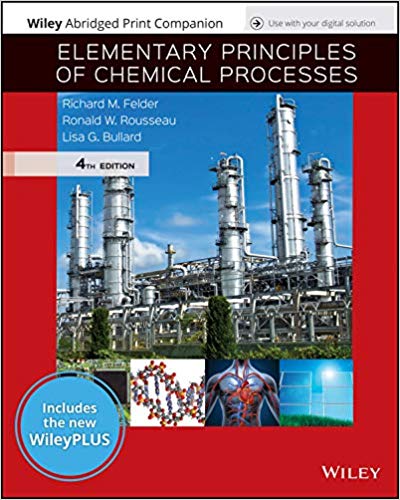Wet wood chips are dried in a continous rotary dryer that operates at atmospheric pressure. The chips
Question:
Wet wood chips are dried in a continous rotary dryer that operates at atmospheric pressure. The chips enter at 19°C with a water content of 40 wt% and must leave with a moisture content of less than 15%. Hot air is fed to the dryer at a rate of 11.6m3(STP)/kg wet chips.
To monitor the performance of the dryer by sampling the exiting chips and determining their moisture content directly would be a cumbersome procedure and almost impossible to automate. Instead, wet- and dry-bulb thermometers are mounted in both the inlet and outlet air lines, and the moisture content of the exiting chips is determined by a material balance.

After the unit goes on-stream, the inlet dry-bulb temperature is found to be 100°C, and the wet bulb temperature is low enough so that the moisture content of the air may be neglected. The dry-bulb temperature of the exiting air is found to be 38°C, and the wet-bulb temperature is 29°C.
(a) Use the psychrometric chart to calculate the absolute humidity (kg H2O/kg dry air) and specific enthalpy (kJ/kg dry air) of the outlet air stream. Then calculate the mass of water in the exiting air per kilogram of wet chips fed, assuming dry air has a molecular weight of 29.0.
(b) Calculate the moisture content of the emerging chips and determine whether the design specification of less than 15% H2O has been achieved.
(c) Suppose a sample of the moist chips leaving the dryer is taken, the moisture content is measured, and the result is significantly different from the value calculated in Part (b). First briefly state how the moisture content was probably measured (keep it simple); then list possible reasons for the difference between the two values; and finally state in which value you would have more confidence and explain why.
(d) If the unit is operating adiabatically and the heat capacity of the dry chips is 1.70 kJ/(kg °C), what is the exit temperature of the chips? (In estimating the specific enthalpy of the entering air, recall that the reference temperature for dry air used in constructing the psychrometric chart of Figure 8.4-1 is 0°C.)
Step by Step Answer:

Elementary Principles of Chemical Processes
ISBN: 978-1119498759
4th edition
Authors: Richard M. Felder, Ronald W. Rousseau, Lisa G. Bullard





